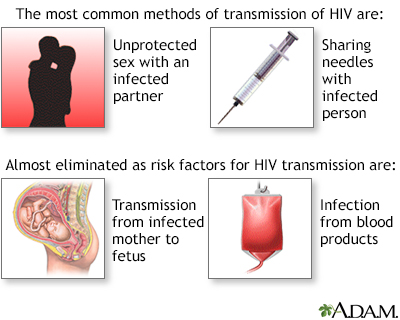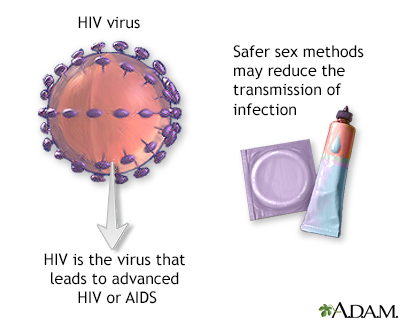HIV/AIDS in pregnant women and infants
HIV infection - children; Human immunodeficiency virus - children; Acquired immune deficiency syndrome - children; Pregnancy - HIV; Maternal HIV; Perinatal - HIV
Human immunodeficiency virus (HIV) is the virus that causes AIDS. When a person becomes infected with HIV, the virus attacks and weakens the immune system. As the immune system weakens, the person is at risk of getting life-threatening infections and cancers. When that happens, the illness is called AIDS.
HIV can be transmitted to the fetus or the newborn during pregnancy, during labor or delivery, or by breastfeeding.
This article is about HIV/AIDS in pregnant women and infants.
Images


I Would Like to Learn About:
Causes
Most children with HIV get the virus when it passes from an HIV-positive mother to the child. This can occur during pregnancy, childbirth, or when breastfeeding.
Only blood, semen, vaginal fluids, and breast milk have been shown to transmit infection to others.
The virus is NOT spread to infants by:
- Casual contact, such as hugging or touching
- Touching items that were touched by a person infected with the virus, such as towels or washcloths
- Saliva, sweat, or tears that is NOT mixed with the blood of an infected person
Symptoms
Most infants born to HIV-positive women in the United States do not become HIV positive if the mother and infant have good prenatal and postpartum care that includes antiretroviral therapy (ART).
Infants who are infected with HIV often have no symptoms for the first 2 to 3 months. Once symptoms develop, they can vary. Early symptoms may include:
- Yeast (candida) infections in the mouth
- Failure to gain weight and grow
- Swollen lymph glands
- Swollen salivary glands
- Enlarged spleen or liver
- Ear and sinus infections
- Upper respiratory tract infections
- Being slow to walk, crawl, or speak compared to healthy babies
- Diarrhea
Early treatment often prevents the HIV infection from progressing.
Without treatment, a child's immune system weakens over time, and infections that are uncommon in healthy children develop. These are severe infections in the body. They can be caused by bacteria, viruses, fungi, protozoa, or parasites. At this point, the illness has become full-blown AIDS.
Exams and Tests
Here are the tests a pregnant mother and her baby may have to diagnose HIV:
TESTS TO DIAGNOSE HIV IN PREGNANT WOMEN
All pregnant women should have a screening test for HIV along with other prenatal tests. Women at high risk should be screened a second time during the third trimester.
Mothers who have not been tested can receive a rapid HIV test during labor.
Woman known to be HIV positive during pregnancy will have regular blood tests, including:
- CD4 counts
- Viral load test, to check how much HIV is in the blood
- A test to see if the virus will respond to the medicines used to treat HIV (called a resistance test)
TESTS TO DIAGNOSE HIV IN BABIES AND INFANTS
Infants born to women infected with HIV should be tested for HIV infection. This test looks for how much of the HIV virus is in the body. In infants born to HIV positive mothers, HIV testing is done:
- 14 to 21 days after birth
- At 1 to 2 months
- At 4 to 6 months
If the result of 2 tests is negative, the infant does NOT have an HIV infection. If the results of any test are positive, the baby has HIV.
Babies who are at very high risk for HIV infection may be tested at birth.
Treatment
HIV/AIDS is treated with ART. These medicines stop the virus from multiplying.
TREATING PREGNANT WOMEN
Treating pregnant women with HIV prevents children from becoming infected.
- If a woman tests positive during pregnancy, she will receive ART while pregnant. Most often she will receive a three-drug regimen.
- The risk of these ART medicines for the baby in the womb is low. The mother may have another ultrasound at the second trimester.
- HIV may be found in a woman when she goes into labor, particularly if she has not previously received prenatal care. If so, she will be treated with ART right away. Sometimes these drugs will be given through a vein (IV).
- If the first positive test is during labor, receiving ART right away during labor can reduce the rate of infection in children to about 10%.
TREATING BABIES AND INFANTS
Infants born to infected mothers start receiving ART within 6 to 12 hours after birth. One or more antiretroviral medicines should be continued for at least 6 weeks after birth.
BREASTFEEDING
HIV-positive women should not breastfeed. This holds true even for women who are taking HIV medicines. Doing so may pass HIV to the baby through breast milk.
Support Groups
The challenges of being a caretaker of a child with HIV/AIDS can often be helped by joining a support group. In these groups, members share common experiences and problems.
Outlook (Prognosis)
The risk of a mother transmitting HIV during pregnancy or during labor is low for mothers identified and treated with ART early in pregnancy. When treated, the chance of her baby being infected is less than 1%. Because of early testing and treatment, there are fewer than 200 babies born with HIV in the United States per year.
If a woman's HIV status is not found until the time of labor, ART can reduce the rate of infection in infants to about 10%.
Children with HIV/AIDS will need to take ART for the rest of their life. The treatment does not cure the infection. The medicines only work as long as they are taken every day. With proper treatment, children with HIV/AIDS can live a nearly normal lifespan.
When to Contact a Medical Professional
Contact your health care provider if you have HIV or are at risk for HIV, and you become pregnant or are thinking of becoming pregnant.
Prevention
HIV-positive women who might become pregnant should talk to their provider about the risk to their unborn child. They should also discuss methods to prevent their baby from becoming infected, such as taking ART during pregnancy. The earlier the woman starts ART, the lower the chance of infection in the child.
Women with HIV should not breastfeed their baby. This will help prevent passing HIV to the infant through breast milk.
References
Clinicalinfo.HIV.gov website. Guidelines for the use of antiretroviral agents in pediatric HIV infection. clinicalinfo.hiv.gov/en/guidelines/pediatric-arv/whats-new-guidelines. Updated January 31, 2023. Accessed February 28, 2023.
Clinicalinfo.HIV.gov website. Recommendations for use of antiretroviral drugs in pregnant women with HIV infection and interventions to reduce perinatal HIV transmission in the United States. clinicalinfo.hiv.gov/en/guidelines/perinatal/whats-new-guidelines. Updated January 31, 2023. Accessed February 28, 2023.
Hayes EV. Human immunodeficiency virus and acquired immunodeficiency syndrome. In: Kliegman RM, St. Geme JW, Blum NJ, Shah SS, Tasker RC, Wilson KM, eds. Nelson Textbook of Pediatrics. 21st ed. Philadelphia, PA: Elsevier; 2020:chap 302.
Weinberg GA, Siberry GK. Pediatric human immunodeficiency virus infection. In: Bennett JE, Dolin R, Blaser MJ, eds. Mandell, Douglas, and Bennett’s Principles and Practice of Infectious Diseases. 9th ed. Philadelphia, PA: Elsevier; 2020:chap 127.
BACK TO TOPReview Date: 9/10/2022
Reviewed By: Jatin M. Vyas, MD, PhD, Associate Professor in Medicine, Harvard Medical School; Associate in Medicine, Division of Infectious Disease, Department of Medicine, Massachusetts General Hospital, Boston, MA. Also reviewed by David C. Dugdale, MD, Medical Director, Brenda Conaway, Editorial Director, and the A.D.A.M. Editorial team. Editorial update 02/28/2023.

Health Content Provider
06/01/2025
|
A.D.A.M., Inc. is accredited by URAC, for Health Content Provider (www.urac.org). URAC's accreditation program is an independent audit to verify that A.D.A.M. follows rigorous standards of quality and accountability. A.D.A.M. is among the first to achieve this important distinction for online health information and services. Learn more about A.D.A.M.'s editorial policy, editorial process and privacy policy. A.D.A.M. is also a founding member of Hi-Ethics. This site complied with the HONcode standard for trustworthy health information from 1995 to 2022, after which HON (Health On the Net, a not-for-profit organization that promoted transparent and reliable health information online) was discontinued. |
The information provided herein should not be used during any medical emergency or for the diagnosis or treatment of any medical condition. A licensed medical professional should be consulted for diagnosis and treatment of any and all medical conditions. Links to other sites are provided for information only -- they do not constitute endorsements of those other sites. © 1997- 2024 A.D.A.M., a business unit of Ebix, Inc. Any duplication or distribution of the information contained herein is strictly prohibited.
